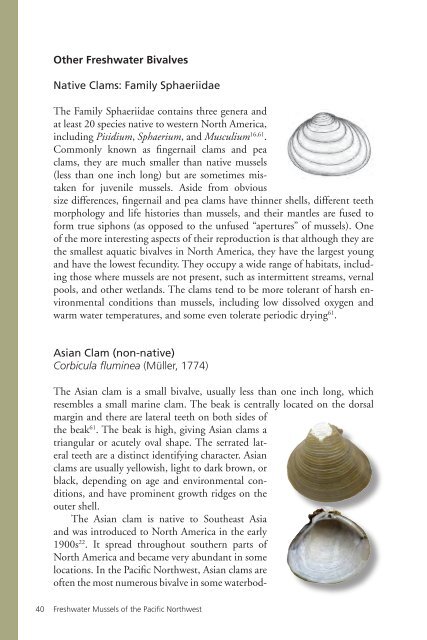Freshwater Mussels Pacific Northwest - The Xerces Society
Freshwater Mussels Pacific Northwest - The Xerces Society
Freshwater Mussels Pacific Northwest - The Xerces Society
You also want an ePaper? Increase the reach of your titles
YUMPU automatically turns print PDFs into web optimized ePapers that Google loves.
40<br />
Other <strong>Freshwater</strong> Bivalves<br />
Native Clams: Family Sphaeriidae<br />
<strong>The</strong> Family Sphaeriidae contains three genera and<br />
at least 20 species native to western North America,<br />
including Pisidium, Sphaerium, and Musculium 16,61 .<br />
Commonly known as fingernail clams and pea<br />
clams, they are much smaller than native mussels<br />
(less than one inch long) but are sometimes mistaken<br />
for juvenile mussels. Aside from obvious<br />
size differences, fingernail and pea clams have thinner shells, different teeth<br />
morphology and life histories than mussels, and their mantles are fused to<br />
form true siphons (as opposed to the unfused “apertures” of mussels). One<br />
of the more interesting aspects of their reproduction is that although they are<br />
the smallest aquatic bivalves in North America, they have the largest young<br />
and have the lowest fecundity. <strong>The</strong>y occupy a wide range of habitats, including<br />
those where mussels are not present, such as intermittent streams, vernal<br />
pools, and other wetlands. <strong>The</strong> clams tend to be more tolerant of harsh environmental<br />
conditions than mussels, including low dissolved oxygen and<br />
warm water temperatures, and some even tolerate periodic drying 61 .<br />
Asian Clam (non-native)<br />
Corbicula fluminea (Müller, 1774)<br />
<strong>The</strong> Asian clam is a small bivalve, usually less than one inch long, which<br />
resembles a small marine clam. <strong>The</strong> beak is centrally located on the dorsal<br />
margin and there are lateral teeth on both sides of<br />
the beak 61 . <strong>The</strong> beak is high, giving Asian clams a<br />
triangular or acutely oval shape. <strong>The</strong> serrated lateral<br />
teeth are a distinct identifying character. Asian<br />
clams are usually yellowish, light to dark brown, or<br />
black, depending on age and environmental conditions,<br />
and have prominent growth ridges on the<br />
outer shell.<br />
<strong>The</strong> Asian clam is native to Southeast Asia<br />
and was introduced to North America in the early<br />
1900s 22 . It spread throughout southern parts of<br />
North America and became very abundant in some<br />
locations. In the <strong>Pacific</strong> <strong>Northwest</strong>, Asian clams are<br />
often the most numerous bivalve in some waterbod-<br />
<strong>Freshwater</strong> <strong>Mussels</strong> of the <strong>Pacific</strong> <strong>Northwest</strong>

















